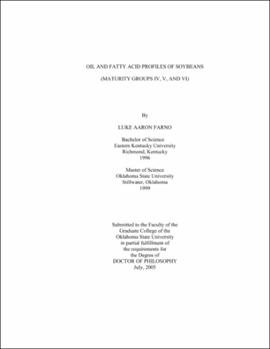| dc.contributor.advisor | Klatt, Arthur | |
| dc.contributor.author | Farno, Luke Aaron | |
| dc.date.accessioned | 2013-12-10T18:04:33Z | |
| dc.date.available | 2013-12-10T18:04:33Z | |
| dc.date.issued | 2005-07 | |
| dc.identifier.uri | https://hdl.handle.net/11244/7726 | |
| dc.description.abstract | Scope and Method of Study: The objective of this research was to evaluate the relationship between grain yield, oil content, and fatty acids composition in soybean cultivars and experimental lines in maturity groups IV, V, and VI. Data were collected at three locations: the Vegetable Research Station at Bixby, OK, the Eastern Research Station at Haskell, OK, and the South Central Research Station at Chickasha, OK. The oil content was determined by using the Soxtec extraction system. Profiles on the percentage of the fatty acids were made by using the AOCS Official Method (Ce2-66) for sampling and analysis of commercial fats and oils. Significant genotype effects and variances were determined by using the PROC MIXED procedure and correlations were determined by using the PROC CORR procedure. | |
| dc.description.abstract | Findings and Conclusions: In 2000, when temperatures were above what was considered optimal for seed development the soybeans had high C18:1 content and low C18:2 and C18:3 contents. Oil percentages should have been higher, but it was found that the soybeans grown at the three locations during 2000 had low oil content when compared to the 18% standard. This was the case for all genotypes that were evaluated. The main cause of this was the heat and/or drought stress that occurred during seed development. In 2001, temperatures were still above optimum, but there was no drought stress during seed development; this led to the fatty acid composition being normal, but oil percentages were still low. Genotypes were identified that had improved fatty acid composition in both years for two or more fatty acids. These may be useful to soybean breeding projects. In both years the oil content of all soybean lines was much lower than the normal 18%. Further studies are needed to determine the cause of this. As has been reported by other, negative correlations were found between C18:2/C18:0, C18:2/C18:1, and C18:3/C18:1. | |
| dc.format | application/pdf | |
| dc.language | en_US | |
| dc.rights | Copyright is held by the author who has granted the Oklahoma State University Library the non-exclusive right to share this material in its institutional repository. Contact Digital Library Services at lib-dls@okstate.edu or 405-744-9161 for the permission policy on the use, reproduction or distribution of this material. | |
| dc.title | Oil and fatty acid profiles of soybeans (maturity groups IV, V, and VI) | |
| dc.contributor.committeeMember | Dashiell, Kenton | |
| dc.contributor.committeeMember | Dunford, Nurhan | |
| dc.contributor.committeeMember | Goad, Carla | |
| osu.filename | Farno_okstate_0664D_1495.pdf | |
| osu.accesstype | Open Access | |
| dc.type.genre | Dissertation | |
| dc.type.material | Text | |
| thesis.degree.discipline | Crop Science | |
| thesis.degree.grantor | Oklahoma State University | |
